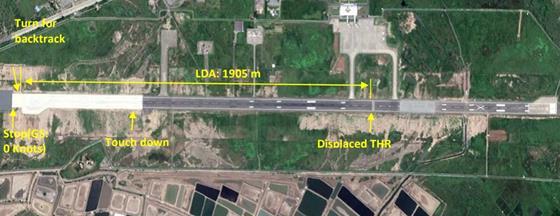Aviation News: Air India A320 left with 600m to stop after unstable approach
Posted: Mon Nov 30, 2020 8:48 pm
Pilots of an Air India Airbus A320 were left with just 600m in which to bring the aircraft to a halt after the jet landed long at Surat following an unstable approach. The threshold of Surat’s runway 22 had already been displaced by 1,000m leaving an available landing distance of 1,905m, according to an inquiry by the Indian government’s western region air safety directorate. It states that the displaced threshold meant the ILS procedure was unavailable and the aircraft, arriving from Delhi on 4 October 2017, was cleared for a localiser-only approach. But the aircraft’s speed throughout the approach was higher than the 135kt target, and its rate of descent was more than 1,000ft/min down to 185ft radio height. At 2nm from the threshold the aircraft was flying above 1,000ft compared with 840ft required. The inquiry says the jet was subjected to “varying tailwind components” during the approach. “The aircraft was continuously high and fast,” it states, adding that it was “not stabilised” by 500ft, a situation which would normally demand a go-around. Although the flare was initiated at 38ft, the aircraft floated for about 7s and only touched down some 12s after the flare commenced – landing about 1,300m beyond even the displaced threshold, and leaving only 600m in which to stop.  Source: Indian government Diagram showing the short distance in which the A320 stopped after the long touchdown The captain immediately applied maximum manual braking and maximum reverse-thrust on touchdown, and while the A320 overran the runway end it remained on the strip. None of the 145 passengers or six crew members was injured and the aircraft was undamaged, although it hit runway lamps while backtracking after the incident. The aircraft involved (VT-ESE) is unusual because, like a number of Air India A320s, each main landing-gear assembly has a four-wheel bogie rather than the normal two wheels. The crew claimed low braking action in a technical log entry. But the inquiry says this was “incorrect”. Weather conditions were good at the time, no abnormalities were found during inspection of the aircraft, and no braking issue was reported either before or after the incident. Cockpit-voice recordings were unavailable, the investigation adds, because the incident was “not reported by the crew”, with the result that the cockpit recorder information was not downloaded.Check out our Aviation and Pilots Forum www.Scudrunners.com
Source: Indian government Diagram showing the short distance in which the A320 stopped after the long touchdown The captain immediately applied maximum manual braking and maximum reverse-thrust on touchdown, and while the A320 overran the runway end it remained on the strip. None of the 145 passengers or six crew members was injured and the aircraft was undamaged, although it hit runway lamps while backtracking after the incident. The aircraft involved (VT-ESE) is unusual because, like a number of Air India A320s, each main landing-gear assembly has a four-wheel bogie rather than the normal two wheels. The crew claimed low braking action in a technical log entry. But the inquiry says this was “incorrect”. Weather conditions were good at the time, no abnormalities were found during inspection of the aircraft, and no braking issue was reported either before or after the incident. Cockpit-voice recordings were unavailable, the investigation adds, because the incident was “not reported by the crew”, with the result that the cockpit recorder information was not downloaded.Check out our Aviation and Pilots Forum www.Scudrunners.com
 Source: Indian government Diagram showing the short distance in which the A320 stopped after the long touchdown The captain immediately applied maximum manual braking and maximum reverse-thrust on touchdown, and while the A320 overran the runway end it remained on the strip. None of the 145 passengers or six crew members was injured and the aircraft was undamaged, although it hit runway lamps while backtracking after the incident. The aircraft involved (VT-ESE) is unusual because, like a number of Air India A320s, each main landing-gear assembly has a four-wheel bogie rather than the normal two wheels. The crew claimed low braking action in a technical log entry. But the inquiry says this was “incorrect”. Weather conditions were good at the time, no abnormalities were found during inspection of the aircraft, and no braking issue was reported either before or after the incident. Cockpit-voice recordings were unavailable, the investigation adds, because the incident was “not reported by the crew”, with the result that the cockpit recorder information was not downloaded.Check out our Aviation and Pilots Forum www.Scudrunners.com
Source: Indian government Diagram showing the short distance in which the A320 stopped after the long touchdown The captain immediately applied maximum manual braking and maximum reverse-thrust on touchdown, and while the A320 overran the runway end it remained on the strip. None of the 145 passengers or six crew members was injured and the aircraft was undamaged, although it hit runway lamps while backtracking after the incident. The aircraft involved (VT-ESE) is unusual because, like a number of Air India A320s, each main landing-gear assembly has a four-wheel bogie rather than the normal two wheels. The crew claimed low braking action in a technical log entry. But the inquiry says this was “incorrect”. Weather conditions were good at the time, no abnormalities were found during inspection of the aircraft, and no braking issue was reported either before or after the incident. Cockpit-voice recordings were unavailable, the investigation adds, because the incident was “not reported by the crew”, with the result that the cockpit recorder information was not downloaded.Check out our Aviation and Pilots Forum www.Scudrunners.com